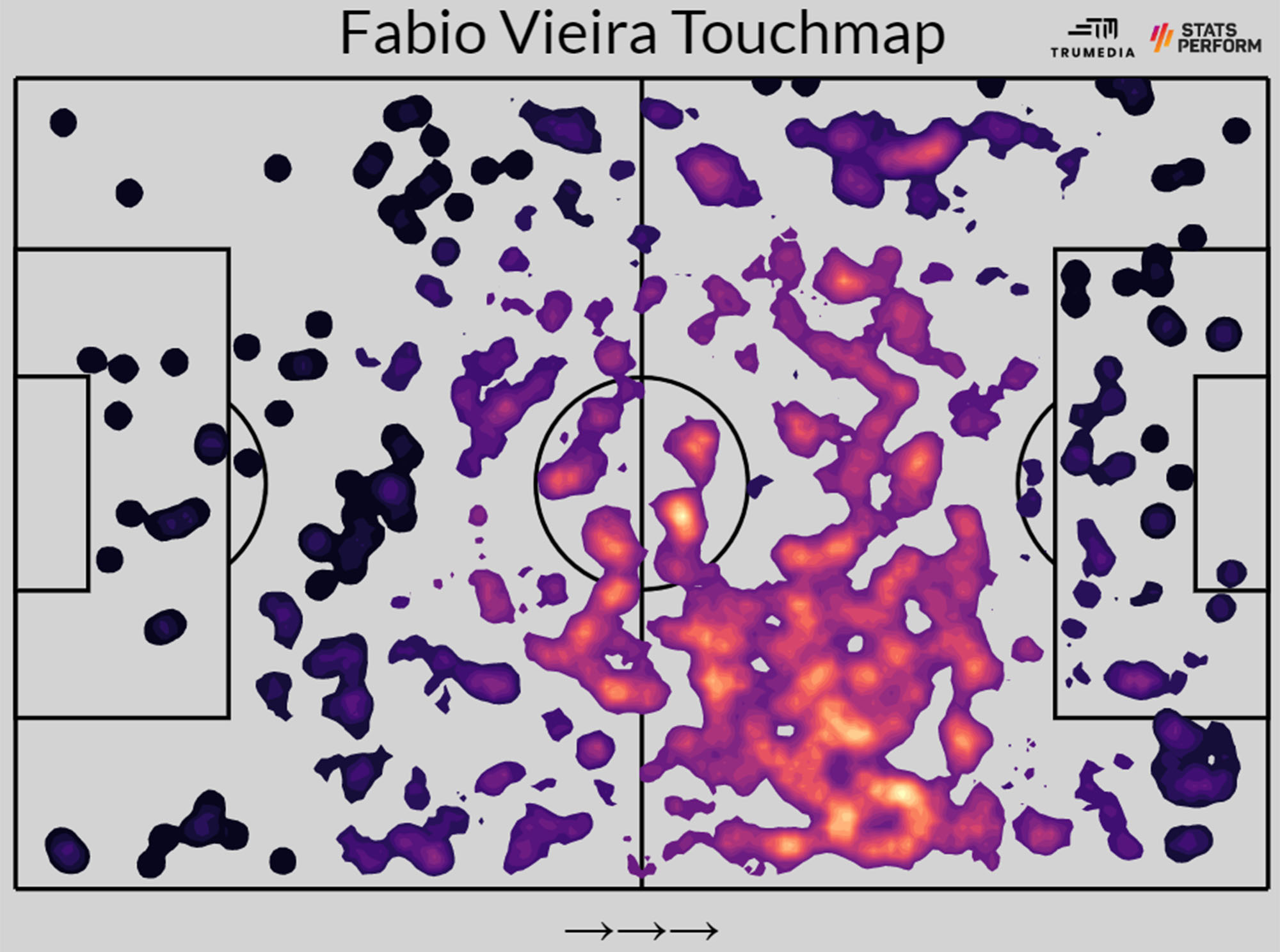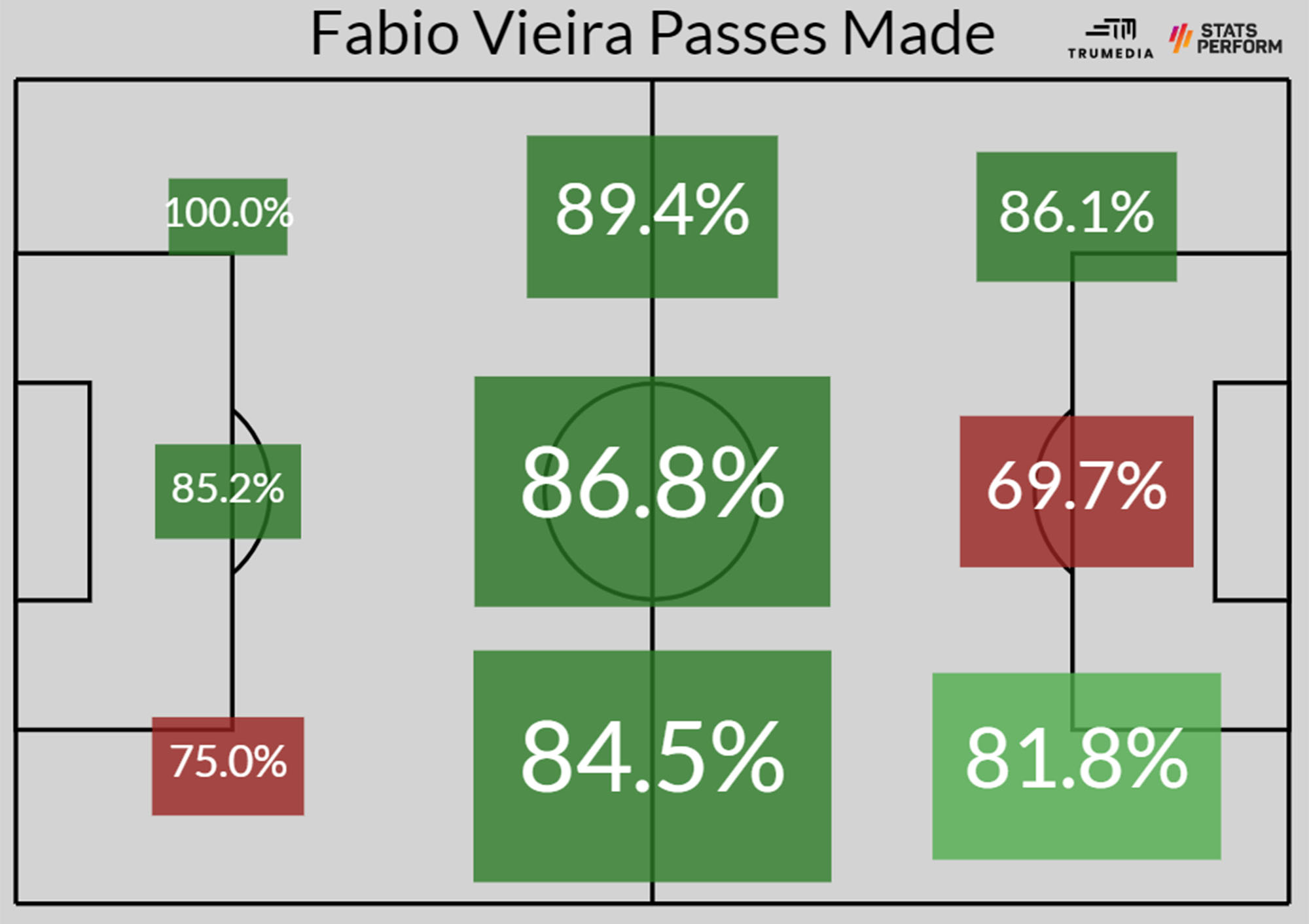Arsenal have agreed a deal to sign FC Porto attacking midfielder Fabio Vieira for €35 million, with a further €5m possible in performance-related add-ons, but what type of player are they getting?
Vieira, 22, played 39 games across all competitions last season, registering seven goals and 16 assists, while in his career for the Portuguese club he had 10 goals and 18 assists from 76 games.
Coming through the club’s youth academy, he made his first-team debut on June 10, 2020 against Maritimo.
He has yet to make his debut for the senior Portugal national team, but he is the captain of the under-21 side and has 13 goals from 20 games since making his debut on Nov. 14, 2019.
He was named in the Team of the Tournament as the Portugal U19s finished second to Spain in the 2019 UEFA European Under-19 Championship, while he also starred at the 2021 UEFA European Under-21 Championship, picking up the award for Best Player as Portugal finished as runners-up behind Germany.
So what can Arsenal expect? We dig into the data, along with asking former scout Tor-Kristian Karlsen and ESPN senior writer James Olley for their assessments.
Position
At 5-foot-7, Vieira lacks the physical size to dominate the midfield like his namesake Patrick Vieira did for years at Arsenal. Indeed, he’s a very different style of midfielder to the legendary Frenchman.
Vieira has played in a number of positions, including as a No. 10, a No. 8 and a second striker. He tends to play centrally behind the striker(s) or cuts in from the right onto his stronger left foot, as his touchmap below shows.

By the numbers
Vieira has some impressive stats among his FC Porto peers this season, playing 27 of the club’s 34 league games on the way to winning a second successive title and the Portuguese cup.
*Stats based on Primeira Liga 2021-22 only.
Touches: 1,082 (10th)
Pass accuracy: 82.9% (16th)
Chances created: 34 (5th)
Shots: 46 (6th)
Tackle accuracy 48.3% (6th)
Expected goals: 3.68 (6th)
Expected assists: 5.00 (3rd)
Strengths
Rapid turns and a change of pace, mixed with a low centre of gravity, make the attacking midfielder a headache for opponents and an entertainer for the fans.
When in form, he can advance forward by slaloming past defenders and is dangerous in the final third. His left foot is excellent, and while he hits a powerful shot, he is also sensitive enough to thread well-weighted passes to runners behind the defensive line. — Karlsen

He was involved in 23% of Porto’s goals in the Portuguese league last season, so he is an attacking threat with an eye for a key pass.
However, he can also score himself and isn’t afraid to take on a shot from distance.

How he can improve
Vieira can be slightly selfish and prone to taking on an opponent too many times. As with most other talents who thrive on their technical ability, he can improve his defensive discipline. There’s also a need to provide a more consistent presence for the entire 90 minutes. — Karlsen
In quotes
Dusan Fitzel, a member of UEFA’s team of technical observers who were on the panel of deciding who would be Player of the Tournament at the 2021 U21 Euros, explained the choice: “During the tournament, he was a key player for Portugal. A playmaker who creates a lot of chances. An excellent link between midfield and attack.”
Manuel Tulipa, the Maritimo U23 manager who coached FC Porto’s U15, U17 and U19 sides from 2017 until 2020, told Maisfutebol: “Fabio Vieira is special because he can see everything with his head on the ground. He is a player who provides assists and can enter the area, score in midrange and in dead-ball situations. He’s also improved in terms of pressing orientation.
“But what most surprises me is the way he displays his quality when many teams use a low block on the pitch, and he can decipher what the game demands. These are the players that are worth a lot of money.”
Who else was he linked with?
Liverpool, Man United and Tottenham have reportedly scouted him in the past.
Why were Arsenal interested?
Another attacking midfielder didn’t appear to be at the top of Arsenal’s priorities this summer but Porto’s willingness to accept a fee below Vieira’s €50m release clause created an opportunity they decided to exploit.
Arteta is keen to add more creativity to the team — and told Sky Sports back in 2020 what adding creative players would do for the club — but he already has Martin Odegaard and Emile Smith Rowe capable of playing as a No. 10, as No. 8s in a 4-3-3 shape, or wide left as Smith Rowe did on several occasions last season.
Odegaard’s importance has been underlined by Arteta handing him the captaincy on occasion towards the end of last season, while sources close to Smith Rowe insist there is no indication he will leave the club — the 21-year-old had been the subject of interest from Aston Villa before signing a new contract — and so Vieira’s addition appears to be adding strength in depth as Arsenal return to the Europa League next term.
The Gunners streamlined their squad in January with no European football and an early exit from the FA Cup meaning they only had the Premier League to concentrate on. Arteta typically targets versatile attacking players and Vieira’s ability to play as a false No. 9 offers an intriguing option, in addition to easing the creative burden on Odegaard and Smith Rowe if he operates in his more customary position. — James Olley
Will he fit in at the Emirates?
Being technically gifted, creative and equipped with an excellent first touch and ball control, Vieira seems the typical Arsenal attacking midfielder as favoured by former manager Arsene Wenger.
On that basis he’d have no problem settling into the team attacking-wise: He can pass with both precision and pace to shift the ball around, while in addition has the end product (the eye and execution of a killer pass or a left-footed long-range effort) and the ability to make line-breaking passes (and runs with the ball) against low-sitting opposition.
His expertise on set pieces is also an added bonus. How he will deal with the defensive side, in a team in which physicality can be lacking from the central attacking midfielders, is another question (example: Odegaard performed a lot more ball recoveries — 162 vs. 59 — and entered more double the amount of defensive duels — 103 vs. 50 — last season compared to Vieira).
Arsenal are clearly confident that there’s a lot more to come from the Portuguese midfielder, but while he’s a player in rapid development, he may not be too far off reaching his ceiling. — Karlsen
